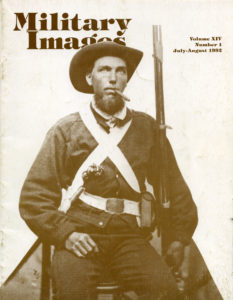The complete issue
Vol. XIV, No. 1
(32 pages)
Print edition: Visit our store to check availability
Digital edition: Visit JSTOR.org to purchase
Subscribe to MI
Explore the MI Archives: Browse | Advanced search | Tutorial
Inside
Cover image
An ambrotype from William R. Gibbs pictures his great-grandfather, Samuel Harrison Gunn, a private in the Lunenburg Heavy Artillery of Virginia.
Editor’s Desk (p. 1)
The editor raises alarm bells about the rise in fake images, and includes a recent case of modern copies that appeared in The Art of the Daguerreotype (1989) by Stefan Richter.
Mail Call (p. 3)
The letters to the editor includes a suggestion about how to mark fake images, praise for the recent World War I weapons survey, and issues with crediting a scholar in the recent Sioux Campaign story.
Passing in Review (p. 5)
Three publications are mentioned, including Compendium of the Confederate Armies (Facts on File) by Stewart Sifakis, Jefferson Davis, The Man and His Hour (Harper Collins) by William C. Davis and The Army Called It Home: Military Interiors of the 19th Century (Thomas Publications) by William L. Brown.
The Gray & The Blue: A Collection of Vignettes from the Brothers’ War (pp. 6-15)
A total of 13 men, 7 Union and 13 Confederate, are profiled here. They include James Magner of the 28th Massachusetts Infantry, Matthew Magner of Mosby’s Rangers, John James Creekmore of the 15th Virginia Cavalry, Young H.E. Hitch of the 16th South Carolina Infantry, William Johnston of the 114th New York Infantry, David Hamilton Morton of the 149th Pennsylvania Infantry and more.
The Independent Blues of Selma, Alabama: A Southern Volunteer Militia Company by Thomas Rodgers (pp. 16-17)
An image taken outdoors of the Independent Blues, part of the collection of the Alabama Department of Archives and History, is accompanied by a text profile of the company, which was founded in July 1859. The Blues became Company D of the 8th Alabama Infantry in 1861, and served in the Army of Northern Virginia through the war.
More Painted Canvas: Another Look at Photographic Backdrops (pp. 18-23)
A survey of 25 images highlights an array of artful backdrops. The photographs are organized in five categories: Classic Backdrops & Exotic Locales, Tenting on the Old Campground, Fortifications, Ships and Postwar Views.
Captain Bob’s Caveat Emptorium (p. 23)
In this installment, the Captain offers up a tintype of a Union infantryman, then reveals that the image was made in 1991 by Bill Dunniway of Mount Hermon, Calif., using a backdrop painted by Richard Staley of San Jose, Calif.
Soldiers of the Signal Corps, 1863-1919 by Anthony Gero (pp. 25-27)
A photo essay of six images from the author’s collection is accompanied by a brief history of the Signal Corps.
Stragglers (pp. 28-29)
Solo photos of the interesting and the unique, from the collections of our readers includes four images: A view of the wagon of Boston photographer G.H. Loomis, a woman who may be a viviandiere or actor, a bereavement card for Civil War soldier Daniel H. Winfield, who was killed at Gettysburg, and an antebellum stereoview of Marines at the Philadelphia Navy Yard.
Sutlers’ Row (pp. 31-32)
Back cover
Three examples of portraits with painted backdrops.



































